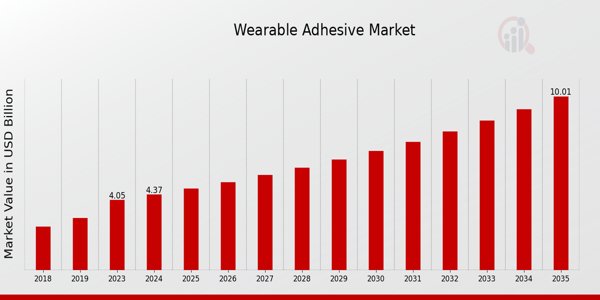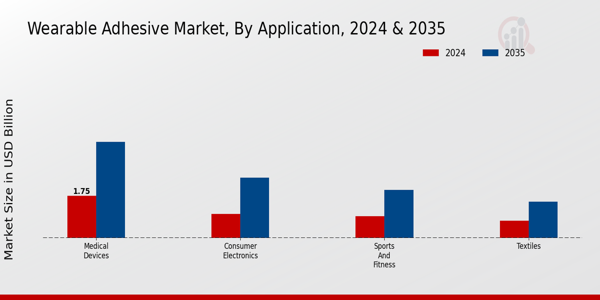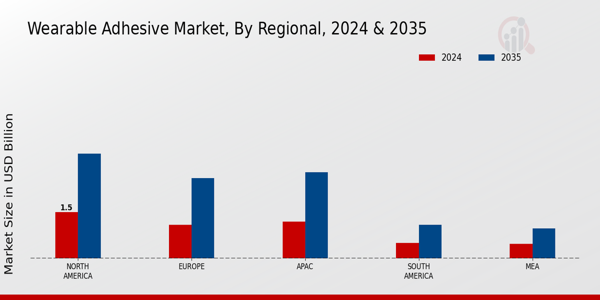Wearable Adhesive Market Overview
As per MRFR analysis, the Wearable Adhesive Market Size was estimated at 4.05 (USD Billion) in 2023.
The Wearable Adhesive Market Industry is expected to grow from 4.37(USD Billion) in 2024 to 10.0 (USD Billion) by 2035. The Wearable Adhesive Market CAGR (growth rate) is expected to be around 7.82% during the forecast period (2025 - 2035).
Key Wearable Adhesive Market Trends Highlighted
The Global Wearable Adhesive Market is influenced by several key market drivers. The increasing demand for comfortable and secure wearables in healthcare, sports, and consumer electronics plays a significant role in this market's growth. Innovations in adhesive technology are fostering the development of products that provide better adhesion, flexibility, and skin compatibility. Additionally, the rise in chronic diseases and the need for continuous health monitoring have led to a greater focus on creating effective wearables that require reliable adhesives. These factors combined are stimulating market expansion and encouraging manufacturers to invest in research and development.There are ample opportunities to be explored in the wearable adhesive sector. As the trend towards smart textiles and health monitoring devices continues to gain traction, manufacturers can focus on creating specialized adhesives that meet the unique needs of these applications.
Moreover, there is growing potential in customizing adhesives to fit various skin types and conditions, enabling better user experiences. Targeting niche markets, such as medical applications where patient comfort and safety are paramount, presents another avenue for growth. The combination of advancements in technology and increasing consumer awareness is paving the way for innovative solutions in the wearable adhesive domain.Recently, trends indicate a shift towards eco-friendly and biocompatible adhesive materials. The heightened awareness about environmental impact is driving demand for sustainable solutions, prompting manufacturers to explore alternative raw materials. Additionally, the integration of smart technology in wearables is influencing adhesive development, as products must now accommodate electronic components seamlessly. Collaboration between adhesive suppliers and device manufacturers is becoming more common, ensuring that adhesive solutions are tailored to specific device requirements. These trends underline the dynamic landscape of the Global Wearable Adhesive Market, emphasizing the importance of innovation and adaptability in meeting evolving consumer needs.

Source: Primary Research, Secondary Research, MRFR Database and Analyst Review
Wearable Adhesive Market Drivers
Rising Demand for Advanced Healthcare Solutions
The Global Wearable Adhesive Market Industry is turning over a new leaf because the healthcare industry is demanding sophisticated products to satisfy its needs. With the medical sector booming, products that are beneficial, along with being effective greatly improve a patient’s outcome. In this regard, wearable adhesives have become quite essential in multiple devices such as tattoos, medical patches, and sensors in order to deliver drugs and monitor the person’s health.
The adhesive’s flexible grip is firm enough to not allow the device to fall off. At the same time, it can be removed without irritating the skin. These attributes, along with advancements in adhesive technology, have led to the development of skin-friendly and hyper allergenic formulas. All of these have prompted the expansion of wearables in the medical field and captured the attention of both healthcare professionals and consumers.
The merging of wearable technology with adhesive formulations would enable patients suffering from chronic diseases to be under proper management and monitoring which greatly enhances healthcare quality. The growing focus on wearables, along with these conditions, will lead to more investment in wearable solutions. As a result of all of this, market growth will widen, and innovative advancements will flourish.
Technological Advancements in Wearable Devices
Technological advancements play a crucial role in the growth of the Global Wearable Adhesive Market Industry. The evolution of wearable devices is marked by increased functionality, durability, and integration with mobile technology, allowing for a user-friendly experience. As these devices become more sophisticated, the need for high-performance adhesives that can withstand diverse applications becomes paramount. The development of specialty adhesives that can maintain their properties under variable conditions assures manufacturers of the reliability needed in connected healthcare.This synergy between technology and adhesive performance significantly enhances usability and drives market penetration.
Growing Fitness and Wellness Trends
The rising trend of fitness and wellness is another significant driver for the Global Wearable Adhesive Market Industry. As more individuals adopt healthier lifestyles, there is an increased uptake of wearable fitness technology that often utilizes advanced adhesive materials. These adhesives are essential in ensuring that devices remain securely attached during physical activity, thus promoting comprehensive tracking of health metrics. The market responds to this trend by expanding the range of adhesives tailored for active lifestyles, which in turn fosters innovation and growth.
Wearable Adhesive Market Segment Insights
Wearable Adhesive Market Application Insights
The Global Wearable Adhesive Market revenue is witnessing substantial growth, particularly within the Application segment, which plays a crucial role in driving market dynamics. In 2024, the overall market is projected to have a valuation of 4.37 USD Billion, with significant contributions from various domains such as Medical Devices, Consumer Electronics, Sports and Fitness, and Textiles. The Medical Devices segment, valued at 1.75 USD Billion in 2024, is set to grow impressively, reaching 4.0 USD Billion by 2035. This segment holds a majority share in the market due to the increasing demand for advanced healthcare solutions like biosensors and wearable devices that monitor health metrics.Similarly, the Consumer Electronics segment, valued at 1.0 USD Billion in 2024, reflects a significant interest as wearable technologies become integral to daily lifestyle, forecasting an increase to 2.5 USD Billion by 2035. The growth in this area can largely be attributed to the rising adoption of smartwatches and fitness trackers, which require reliable adhesive solutions for various wearable components.
The Sports and Fitness segment, although smaller, valued at 0.9 USD Billion in 2024, is anticipated to grow to 2.0 USD Billion by 2035, indicating a rising trend in wearable devices that track performance and health during physical activity, showcasing its importance in athletic training and health monitoring.Lastly, the Textiles segment, valued at 0.72 USD Billion in 2024, is also projected to grow to 1.5 USD Billion by 2035, reflecting an emerging trend of integrating technology with fabrics, which allows for smart clothing applications. Each of these segments contributes uniquely to the overall Global Wearable Adhesive Market statistics, driven by technological advancements and increased consumer awareness. The market growth is propelled by factors such as the rising preference for personal health monitoring and the incorporation of adhesive technologies in innovative products.However, challenges such as material limitations and regulatory hurdles are pertinent, impacting how quickly these segments can adapt. Overall, the Global Wearable Adhesive Market segmentation highlights a vibrant landscape where applications vary in valuation and importance, yet together, they depict a promising future for the entire industry.

Source: Primary Research, Secondary Research, MRFR Database and Analyst Review
Wearable Adhesive Market Type Insights
The Global Wearable Adhesive Market is anticipated to achieve a valuation of 4.37 USD Billion by 2024, with significant growth projected in the following years. The market comprises various types of adhesives, including Hydrocolloid Adhesives, Silicone Adhesives, and Acrylic Adhesives, each holding unique applications and benefits. Hydrocolloid Adhesives are particularly essential for medical applications due to their moisture management and skin-friendly properties, which promote faster healing. Silicone Adhesives are recognized for their flexibility and durability, making them ideal for applications requiring movement, enhancing user comfort in wearable devices.Acrylic Adhesives dominate sectors needing strong immediate adhesion and quick bonding capabilities, often utilized in everyday consumer products. The diversity in the type of adhesives reflects the market's adaptability to consumer needs and advances in technology, contributing to the overall growth and innovation within the Global Wearable Adhesive Market industry. Factors driving this market include the rising demand for healthcare solutions, increased awareness of skin-friendly materials, and the growing market for wearable technologies, which present new opportunities for further segmentation and targeted applications.
Wearable Adhesive Market End Use Insights
The Global Wearable Adhesive Market is experiencing significant growth, with an expected valuation of USD 4.37 billion by 2024. This market encompasses several important End Use sectors, including Healthcare, Consumer Goods, and Industrial applications. The Healthcare sector plays a crucial role as it utilizes wearable adhesives in medical devices, monitoring systems, and skin applications, thereby addressing the increasing demand for patient comfort and effective treatment solutions. Consumer Goods also hold a substantial share as wearable adhesives are commonly used in fitness trackers and smart clothing, catering to a growing health-conscious population.Additionally, the Industrial sector benefits from wearables for safety and monitoring purposes, enhancing productivity. Overall, the Global Wearable Adhesive Market segmentation reflects a diverse landscape fueled by evolving consumer preferences, advancements in technology, and the pursuit of innovative applications. Market growth in these areas presents numerous opportunities, although challenges remain, such as material compatibility and regulatory compliance across various sectors.
Wearable Adhesive Market Form Factor Insights
The Global Wearable Adhesive Market, valued at 4.37 USD Billion in 2024, is witnessing significant growth driven by diverse Form Factor segments. This market encompasses various products, including Flexible Patches, Wearable Sensors, and Smart Fabrics, each contributing uniquely to the market evolution. Flexible Patches play a crucial role by providing comfort and adaptability, making them ideal for long-term skin contact in various applications such as health monitoring and drug delivery. Meanwhile, Wearable Sensors are increasingly pivotal, enabling accurate data collection and enhancing user interaction across diverse fields, including fitness and medical diagnosis.Smart Fabrics represent a significant segment, integrating electronics and textiles to create multifunctional solutions, which cater to both fashion and functionality. The diverse nature of these Form Factor segments contributes to the market’s revenue growth, driven by increasing consumer demand for health management and active lifestyle products. Market trends indicate a strong inclination towards innovative wearable technology, which further fuels the Global Wearable Adhesive Market Statistics. Amidst these developments, challenges such as regulatory hurdles and product compatibility persist, creating a dynamic environment rich with opportunities in the market.
Wearable Adhesive Market Regional Insights
The Global Wearable Adhesive Market reflects a diverse distribution across various regions, with North America leading the way with a valuation of 1.5 USD Billion in 2024 and expected to reach 3.4 USD Billion by 2035, indicating its dominance in the market due to significant consumer demand and technological advancements. Europe follows closely, valued at 1.1 USD Billion in 2024 and projected to grow to 2.6 USD Billion by 2035, representing a steady demand in healthcare applications. The APAC region, valued at 1.2 USD Billion in 2024, is poised for substantial growth, reaching 2.8 USD Billion by 2035 as it capitalizes on the expanding healthcare sector and increasing disposable incomes.South America demonstrates a relatively smaller market size, valued at 0.5 USD Billion in 2024 and increasing to 1.1 USD Billion by 2035, albeit its growth potential remains promising with rising healthcare awareness. Meanwhile, the MEA region, holding a value of 0.47 USD Billion in 2024, is expected to see growth to 0.97 USD Billion by 2035 as it gradually embraces the benefits of wearable technology, though it remains the least dominant in comparison. The regional segmentation clearly indicates variations in market potential, with North America significantly holding the majority share, driven by innovation and market needs.

Source: Primary Research, Secondary Research, MRFR Database and Analyst Review
Wearable Adhesive Market Key Players and Competitive Insights
The Global Wearable Adhesive Market is characterized by a dynamic and competitive landscape shaped by various factors, including technological advancements, consumer preferences, and regulatory changes. As the demand for wearable medical devices and smart technology increases, companies in this sector are focusing on innovative adhesive solutions that enhance product performance and user experience. Competitive insights in this market illustrate a landscape where firms strive for differentiation, emphasizing customization and the ability to meet specific application needs. With a growing emphasis on comfort, breathability, and sensitivity, players in the wearable adhesive market are continuously developing advancements in materials and bonding technologies to cater to a diverse range of applications, from healthcare to fitness tracking.Scapa Group stands out in the wearable adhesive market due to its strong commitment to research and development, enabling the company to create high-quality adhesive solutions tailored for healthcare applications.
The company's extensive expertise in advanced manufacturing technologies and its ability to adapt to market demands have equipped Scapa Group with a significant market presence. One of the strengths of Scapa Group is its focus on collaboration with healthcare professionals to better understand the requirements of end-users, leading to the development of innovative adhesive products that enhance user comfort and device usability. Furthermore, Scapa Group’s dedication to sustainability and environmentally-friendly practices positions it favorably in a market that increasingly values green credentials.B. Braun operates as a prominent player in the Global Wearable Adhesive Market, leveraging its comprehensive portfolio of healthcare products to cater to the evolving needs of medical professionals and patients.
The company emphasizes high-performance adhesives, which are crucial for securing wearable devices while maintaining skin integrity and ensuring patient comfort. A key strength of B. Braun lies in its global reach and established distribution networks, allowing it to effectively serve a broad customer base. Additionally, the company’s emphasis on innovation and technological advancement fosters the development of adhesive solutions that exemplify reliability and effectiveness in clinical settings. Through strategic partnerships and continuous improvement of its product offerings, B. Braun maintains competitiveness in the dynamic landscape of wearable adhesives, underscoring its commitment to enhancing patient care and safety.
Key Companies in the Wearable Adhesive Market Include
- Scapa Group
- B. Braun
- Adhesive Applications
- Hollister
- 3M
- Smith and Nephew
- Primex Healthcare
- Avery Dennison
- Convatec
- American Medical Systems
- Dermarite Industries
- Tyco Healthcare
- Medtronic
- Johnson and Johnson
Wearable Adhesive Market Industry Developments
The Global Wearable Adhesive Market has seen significant developments, with several key players making strides in innovation and market expansion. Companies like 3M and Johnson & Johnson are actively pushing forward their research to enhance adhesive technologies for improved skin compatibility and wear time. Scapa Group has introduced new product lines tailored for wound care, aiming to meet the growing demand in healthcare markets. Adhesive Applications has focused on sustainability, developing eco-friendly adhesives that align with current environmental standards. Mergers and acquisitions are also prominent; 3M’s acquisition of a small technology firm specializing in medical adhesives is expected to bolster its product capabilities. Reports indicate that B. Braun and Medtronic are exploring collaborative ventures that may enhance their market reach and product offerings. The market valuation for companies in this sector has been increasing, driven by rising healthcare needs and an aging population, which is contributing to heightened competition among companies like Hollister, Smith & Nephew, and Convatec in catering to diverse healthcare applications. The focus on advanced technology and consumer-centric products continues to impact market dynamics significantly.
Wearable Adhesive Market Segmentation Insights
-
Wearable Adhesive Market Application Outlook
- Medical Devices
- Consumer Electronics
- Sports and Fitness
- Textiles
-
Wearable Adhesive Market Type Outlook
- Hydrocolloid Adhesives
- Silicone Adhesives
- Acrylic Adhesives
-
Wearable Adhesive Market End Use Outlook
- Healthcare
- Consumer Goods
- Industrial
-
Wearable Adhesive Market Form Factor Outlook
- Flexible Patches
- Wearable Sensors
- Smart Fabrics
-
Wearable Adhesive Market Regional Outlook
- North America
- Europe
- South America
- Asia Pacific
- Middle East and Africa
| Attribute/Metric Source: |
Details |
| MARKET SIZE 2023 |
4.05(USD Billion) |
| MARKET SIZE 2024 |
4.37(USD Billion) |
| MARKET SIZE 2035 |
10.0(USD Billion) |
| COMPOUND ANNUAL GROWTH RATE (CAGR) |
7.82% (2025 - 2035) |
| REPORT COVERAGE |
Revenue Forecast, Competitive Landscape, Growth Factors, and Trends |
| BASE YEAR |
2024 |
| MARKET FORECAST PERIOD |
2025 - 2035 |
| HISTORICAL DATA |
2019 - 2024 |
| MARKET FORECAST UNITS |
USD Billion |
| KEY COMPANIES PROFILED |
Scapa Group, B. Braun, Adhesive Applications, Hollister, 3M, Smith and Nephew, Primex Healthcare, Avery Dennison, Convatec, American Medical Systems, Dermarite Industries, Tyco Healthcare, Medtronic, Johnson and Johnson |
| SEGMENTS COVERED |
Application, Type, End Use, Form Factor, Regional |
| KEY MARKET OPPORTUNITIES |
Rise in healthcare wearable devices, Growing demand for advanced adhesives, Increasing applications in sports industries, Surge in elderly care solutions, Technological advancements in adhesive materials |
| KEY MARKET DYNAMICS |
increased adoption of wearables, growing healthcare applications, advancements in adhesive technology, rising demand for comfort, sustainability concerns in materials |
| COUNTRIES COVERED |
North America, Europe, APAC, South America, MEA |
Frequently Asked Questions (FAQ) :
The Global Wearable Adhesive Market is expected to be valued at 10.0 billion USD by the year 2035.
The Global Wearable Adhesive Market is projected to grow at a CAGR of 7.82% from 2025 to 2035.
The Medical Devices segment is expected to have the highest market value at 4.0 billion USD by 2035.
The North America region is expected to reach an estimated market value of 3.4 billion USD by 2035.
Key players include Scapa Group, B. Braun, 3M, and Johnson and Johnson among others.
The Consumer Electronics application segment is valued at 1.0 billion USD in the year 2024.
The Sports and Fitness application segment is projected to be worth 2.0 billion USD in 2035.
The market value for Europe is anticipated to reach 2.6 billion USD by 2035.
Emerging trends in healthcare technology and consumer electronics present significant growth opportunities in the market.
The Textiles application segment is expected to reach a market size of 1.5 billion USD by 2035.
















